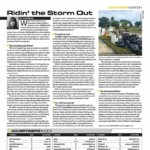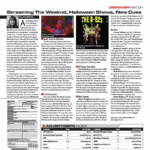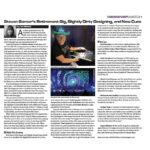Metallica is known for making memorable concert moments. It could start out simply as a little pre-planned spark of a lighting fixture that would trigger crashing light towers, destroying the set to a controlled chaos while the bewildered audience sometimes raced for the exits. Variations of these destruction scenes over the years loom large in their legacy. Now they’ve poured all these gags in a virtual cement mixer, set the volume to “roar” and captured it on film — 3D IMAX, no less.
It took three years, three cities, 24 simultaneous cameras and never-before-seen embellishments of the “greatest concert gags” Metallica has ever performed in its history of touring to capture the American heavy metal rock band in 92 minutes of glory. Metallica Through The Never hit IMAX 3D theatre screens Sept. 27 in North America and was set to go wide starting Oct. 4.
In the film’s story line, a young roadie named Trip is sent on an urgent mission that turns into a surreal adventure, while Metallica performs its most iconic songs in a sold-out arena. The result is “a bracing, raw and visceral cinematic experience,” boasts the film publicity.
PLSN caught up with Metallica’s lighting team for some insight into what it took to translate their touring designs into the film’s concert scenes.
 John Broderick, the concert lighting designer on the film, has served as LD for Metallica for 25 years. Joining in the conversation are Rob Koenig, the concert lighting director and programmer in the film, with the band for five years, and Troy Eckerman, also the programmer for the concert scenes, an 11-year Metallica veteran.
John Broderick, the concert lighting designer on the film, has served as LD for Metallica for 25 years. Joining in the conversation are Rob Koenig, the concert lighting director and programmer in the film, with the band for five years, and Troy Eckerman, also the programmer for the concert scenes, an 11-year Metallica veteran.
PLSN: Describe the film’s timeline.
John Broderick: The original meetings with band, management and concert show designer Mark Fisher took place in the summer of 2010. Band manager Peter Mensch and I were discussing it in the autumn of that year. We spent the entire summer of 2011 in an airplane hangar on Treasure Island [an artificial island between San Francisco and Oakland, CA] under the San Francisco Bay Bridge, then several more months of development, followed by a complete rebuild in spring and summer 2012. The final concert filming was completed in September 2012, but the narrative filming continued after that.
Where did the filming of the concert scenes take place?
 Rob Koenig: We started with an eight-show run in Mexico City, two shows in Edmonton, then two in Vancouver for the filming. The show required 36 trucks to be packed up and be capable of touring.
Rob Koenig: We started with an eight-show run in Mexico City, two shows in Edmonton, then two in Vancouver for the filming. The show required 36 trucks to be packed up and be capable of touring.
John, did your role expand beyond concert lighting
designer in the film?
John Broderick: Due to my long association with the group, there was a level of assisting the film team to absorb the “culture” of Metallica, i.e., their relationship with their fans, their approach to performance, etc.
What ideas did the band contribute?
John Broderick: Peter Mensch spearheaded the idea of an “iconic history” 3D film. But then, of course, the band members, who all have artistic eyes and innovative, forward-thinking approaches, and who are not afraid to go way past comfort zones, became part of the vanguard.
I’ve heard the film included performances of “favorite hits” of production gags in Metallica shows over the years.
John Broderick: Yes, Mark Fisher’s production design incorporated iconic imagery, effects, and effects from the band’s 30-plus years of musical releases and concert tours, but all embodied and alive! The giant electric chair and the Tesla coils are from the cover of the album Ride the Lightning [1984]. The crosses are from Master of Puppets [1984-86]. The Lady Justice statue came from the Justice tour [1988]. The hydraulic towers were part of the Load tour [1995-1996]. But everything is bigger now than it was on those tours!
What were you able to do for the film that you could not or were unable to do on tour?
John Broderick: An important fact regarding this film is that the entire massive show was designed and produced solely for the film. So I always envisioned the lighting in a 3D film space, and positioned instruments and built cues for the 3D camera environment. This approach was invaluable for lighting the set pieces and objects, audience and arena architecture so that they showed real depth and dimension.
How did the film’s lighting needs affect your concert lighting design?
John Broderick: The production has no projections of the live performers on any surfaces. So during the eight warm-up shows in Mexico City, I necessarily had to brighten the key spotlights on the performers so they were the focal points of the production when needed. But as we all know, this intensity level on a performer’s face is far too bright for a camera close-up. We were looking for a much darker, mysterious, moody look for the film, which would complement the narrative portion. Also, the cameras we were using had a wide dynamic range, so less light was desirable much of the time.
Troy, describe the programming timeline.
Troy Eckerman: Most of my work was done over the two summers — 2011 in Treasure Island (San Francisco) for two months. The two months in the summer of 2012 were in Oakland, then to Mexico City, then Canada for the movie.
John Broderick: Troy was with us for the entire time, unlike a normal touring production, where the programmer exits once the cues are set up. We needed his expertise!
Compare programming for the film as compared to
programming for a concert tour.
Troy Eckerman: Programming a film is different, because we are always looking at intensity levels on everything: the band, the set, the audience. We still had the thousands of cues, just like the touring show.
We ended up changing some of the stage and set pieces after the first two months of programming in 2011. We also changed out the fixture types in a few places. It is always a challenge for focuses in the round. You really need to walk the room’s 360 degrees when updating graphic focuses. We moved the console several times during the programming and playback. This gave us a better perspective for the 360-degree gig.
Sometimes paying attention to the lighting system was a challenge. It was very spread out. On top of that, when the fire, lasers and video were all going, there was a lot to look at. Especially during the destruction scene.
Any programming anecdotes?
Troy Eckerman: My favorite programming moment was when I was asked to make moving lights look like they were broken, and in some cases, program them in the process of breaking and blowing up. It was really fun. It was a random free-for-all for certain lights in the system. This is the first show I have ever done where someone wanted the lights to look broken. All I can say is it was fun to break the lights with good working DMX, power, and a perfectly good fixture.
What did you learn from working on the film?
John Broderick: Anything one does is an education. To work with this number of 3D cameras, for an in-the-round concert film, with some of the most experienced 3D wizards in the world, was a re-education in itself. I made sure, when time permitted, to go to each of the experts on site and ask them to explain the workings, whether it was a 3D camera or the stereographer’s seat or the DP’s approach to filming. They were all incredibly gracious.
Rob Koenig: Some conventions of concert lighting, and lighting a Metallica show for film, had to be thrown out the window, because now we were adding the 3D and IMAX elements while still keeping a mysterious vibe for Metallica.
Have you seen the final edited version of the film?
What did you think?
John Broderick: I attended the U.S. premiere [Sept. 16, 2013] in San Francisco. The 3D juxtaposition of an apocalyptic narrative and a concert film, where events in the narrative launch you into the concert, and vice versa, was a true adrenaline rush!
Reach Debi Moen at dmoen@plsn.com.


